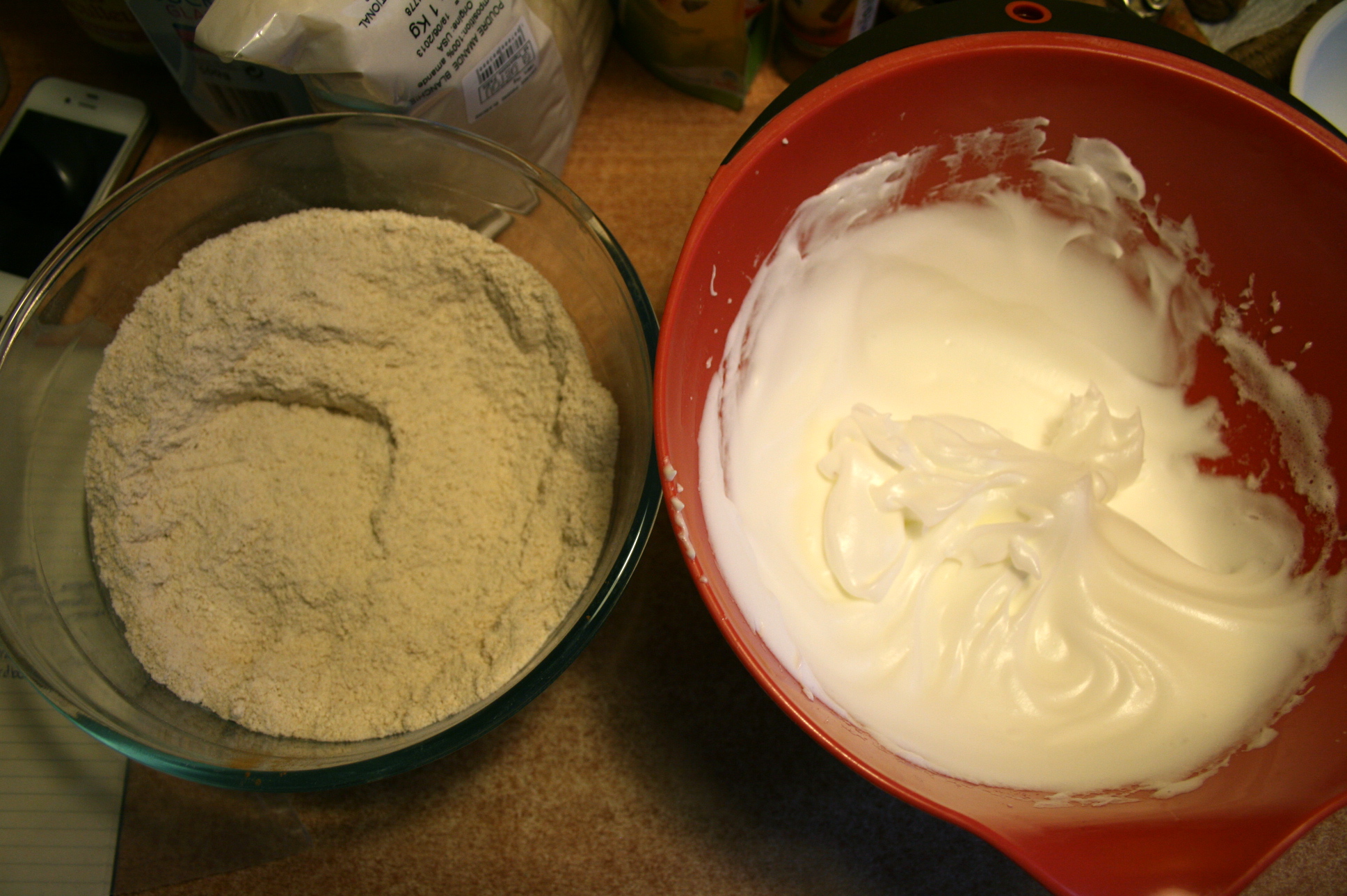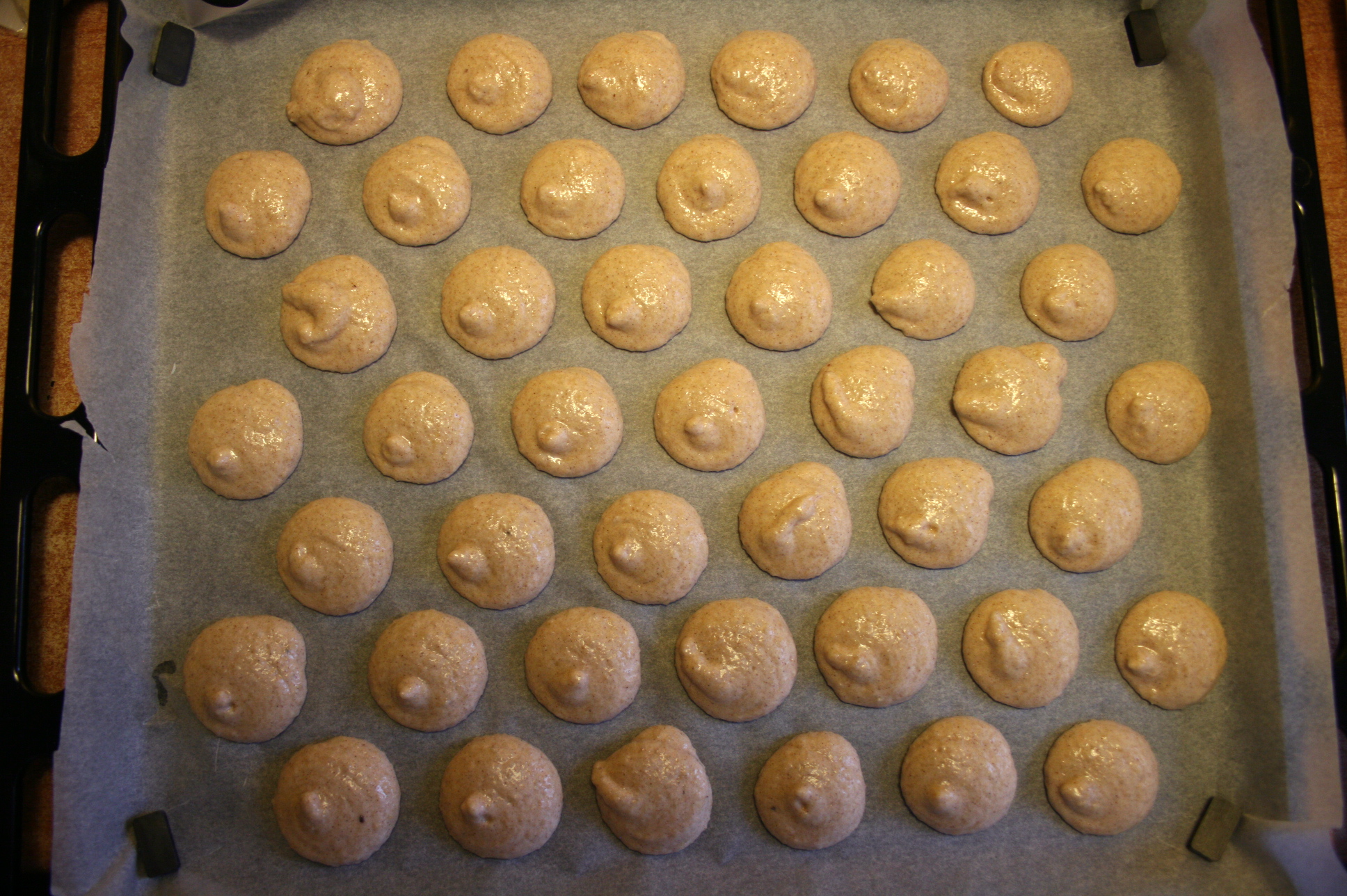Ideally the shells should look smoother than this. Read on to learn from my mistakes.
If I were to open a single-concept bakery it would probably be centered on macaroons. (I like the idea of a pie bakery too but this fad has already taken off in my hometown). I've always maintained that cupcakes are vastly overrated, so their popularity is a mystery to me. IMO they don't require much skill or artistry, so it is with great skepticism that I observe people willing to shell out $4 a cupcake or $40 a dozen. Personally I would much rather just eat a normal-sized cake, because even if you eat a cupcake the right way it still gets kind of messy.
Macaroons, on the other hand, require a lot more finesse. From the ingredients (e.g. aged vs. fresh egg whites) to the technique (e.g. how long to wait before putting them in the oven), there is no consensus regarding the "right way" to make macaroons. A Google search will yield a myriad of different procedures, but I just followed the method they taught us at LCB.
Below is the recipe I used to make cinnamon macaroons. (The French name is the title of this post because it sounds more exotic, doesn't it?) Mostly I just wanted to use the spice because I love the flavor and it's very under-utilized in French baking. Also, Snickerdoodles seem somewhat passé now that I'm a certified intermediate pastry chef.
Using the proportions of the key ingredients (powdered sugar, ground almonds, egg whites, granulated sugar) you can flavor them, dye them and fill them however you want. Fruity macaroons are nice, but I'm also partial to chocolate, coffee, salted caramel, and pistachio. If you're ever in Paris you must try the ones from Pierre Hermé and Ladurée, two of the most famous pâtisseries.
What you need:
- 300 g powdered sugar
- 180 g ground almonds
- 5 g cinnamon
- 150 g egg whites
- 70 g granulated sugar
What you do:
Combine the first three ingredients with a whisk to ensure there aren't any lumps
In a separate bowl, begin beating the egg whites. Gradually add the granulated sugar once soft peaks have been achieved. Continue to mix until firm peaks form.
Times like these make me long for my KitchenAid at home.
Fold the dry ingredients into the egg whites. You can start by using a rubber spatula, but eventually want to use a pastry scraper so you can "macaroné" the mixture.
I should have done this a few more times (that's why the final product still looks lumpy) but in my defense I was rushing because I had to pick the kids up from school.
To do this you will use the scraper to bring the batter up to the rim of the bowl, rotating it as you do so. The point is to make the mixture smooth and shiny. Collect the batter at the bottom of the bowl and repeat several times as necessary.
Prepare a piping bag with a 10mm tip and pipe the batter into uniformly sized circles onto a baking sheet covered with parchment paper or silicon. The batter should be runny enough from smearing it around the bowl that the small peaks that result from piping should sink back into the cookie.
Clearly uniformity is not my forte. At school I usually try to surreptitiously eat the most uneven/asymmetrical ones before chef comes around and sees.
Preheat the oven to 155C.
Let the cookies rest on the sheet until they are no longer sticky to the touch, about 15 minutes. Some people like to skip this step, but the way it was explained to us in class, the resting period is crucial for forming an initial shell. During baking the air can't escape through the top, and thus is forced out along the edge where the shell meets the pan, resulting in the "feet" at the bottom.
See the feet? At least I got one thing right.
Bake for about 15 minutes. Immediately remove the parchment paper from the baking sheet.
Once cool, gently peel the shells off the paper and flip them over. Pair them up by size. Pipe a small amount of filling onto half of the shells, placing the other half on top to make a sandwich. There should be enough filling inside for a thin layer to be visible between the two cookies.
I filled these with what basically amounts to cream cheese frosting. Unfortunately I neglected to write down the quantities of the ingredients, but a 2:1 ratio of cream cheese to butter, plus a dash of vanilla and enough powdered sugar to make a smooth, pipe-able consistency should suffice.
Refrigerate the finished macaroons for at least 24 hours to allow the flavors to meld.




